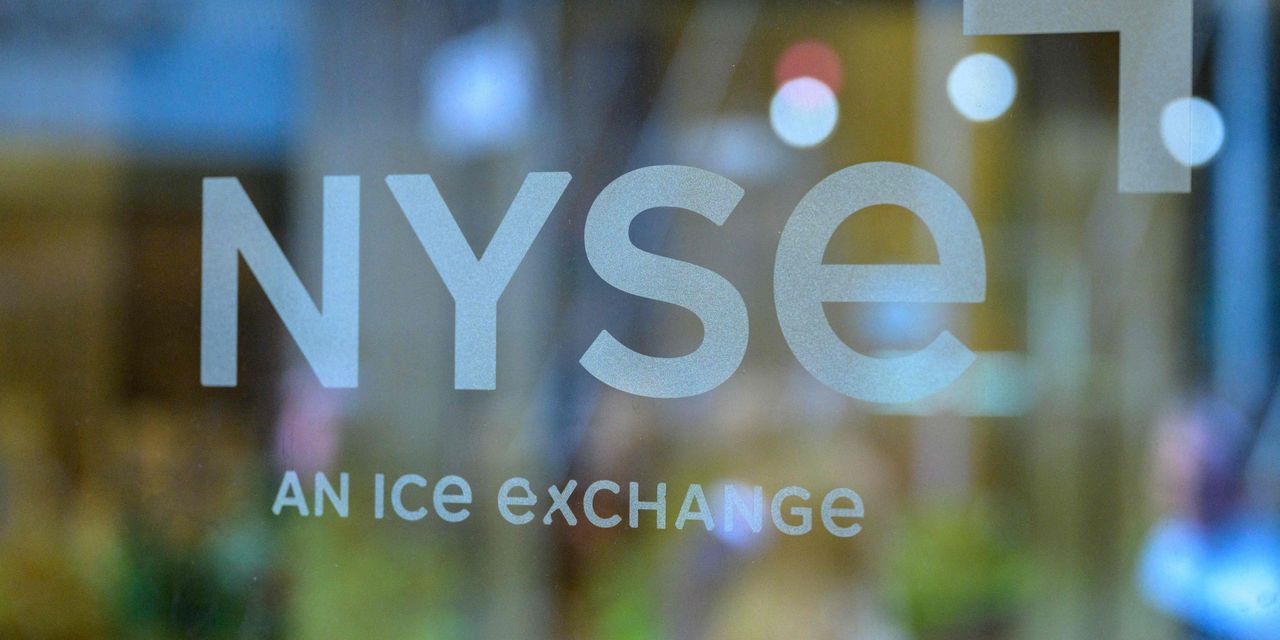U.S. stocks ended lower in choppy trading Tuesday, as bank shares slid following downgrades of smaller players by S&P Global and investors awaited a speech at the end of the week by Federal Reserve Chair Jerome Powell.
What’s happening
-
The Dow Jones Industrial Average
DJIA
fell 174.86 points, or 0.5%, to close at 34,288.83. -
The S&P 500
SPX
finished with a loss of 12.22 points, or 0.3%, at 4,387.55. -
The Nasdaq Composite
COMP
ended at 13,505.87, with a gain of 8.28 points, or 0.1%.
On Monday, the S&P 500 and Nasdaq Composite ended higher, snapping four-day losing streaks, while the Dow booked a modest loss.
What’s driving markets
S&P’s credit rating downgrades came days after a Fitch Ratings analyst reduced his operating environment score for U.S. banks to aa- from aa due to the unknown path of interest rate hikes and regulatory changes facing the sector. Moody’s Investors Service just two weeks ago upset investors when it downgraded some lenders and said it was reviewing ratings on bigger banks.
The SPDR S&P Bank ETF
KBE
dropped 2.5%, while financials fell 0.9% to lead S&P 500 sectors to the downside.
See: U.S. banks and regional lenders slide across the board as S&P is latest to downgrade ratings
Meanwhile a slew of disappointing earnings results from retailers, including Dick’s Sporting Goods Inc.
DKS,
and Macy’s Inc.
M,
set a downbeat tone for the industry, with the SPDR S&P Retail ETF
XRT
declining 2.8%.
Traders also have one eye on a likely catalyst later in the week. Federal Reserve Chair Jerome Powell is scheduled to deliver a speech at the Kansas City Fed’s annual monetary policy symposium in Jackson Hole, Wyo., on Friday.
Powell’s words are “likely to be the next acid test for markets, with particular scrutiny likely to land on any outlook comments. The battle against inflation, as evidenced by the recent consumer-price index, is not yet over, with the level still above the Fed’s 2% target,” said Richard Hunter, head of markets at Interactive investor.
A suggestion from Powell “that investment and therefore potential economic growth may be moving higher, as a result of the climate transition or digital infrastructure required for artificial intelligence, could be perceived as hawkish, since it would suggest that the policy rate could stabilize at a higher level,” said Lauren Goodwin, economist and portfolio strategist at New York Life Investments, in a note.
“From an investment perspective, if the path of the Fed Funds rate is higher because of more sustained investment and GDP growth, than the increases in interest rates can be more stable and less disruptive for investors,” she said. “It’s increases in the term premium, or supply and demand issues, like we have seen amid voluminous Treasury market auctions in recent weeks, that set the stage for more volatile rates markets.”
The S&P 500 is down more than 4% so far in August, as the benchmark 10-year Treasury yields have risen to a 16-year high, in a move sparked in part by concerns about booming supply of debt and on stronger-than-expected economic data of late.
The yield on the 10-year Treasury note
BX:TMUBMUSD10Y
was down around 138 basis points at 4.323%, after ending New York trading on Monday at its highest since November 2007.
Read: Here’s what one firm fears could go wrong with the S&P 500
Stocks on Monday, however, managed to gain ground despite a further rise in yields, a move attributed to optimism ahead of results from Nvidia Corp.
NVDA,
due Wednesday, seen as a bellwether for artificial-intelligence investment plays. Nvidia shares jumped more than 8% Monday, but gave back 2.8% in Tuesday’s session.
“Nvidia had better meet its $11 [billion] sales forecast for last quarter, otherwise, there is a chance that we will see a sizable downside correction,” said Ipek Ozkardeskaya, senior analyst at Swissquote Bank.
Need to Know: Nvidia may be the AI stock for now, but here are the picks for later, says Goldman Sachs
The U.S economic calendar featured existing-home sales. The National Association of Realtors said sales of previously owned homes fell by 2.2% to an annual rate of 4.07 million in July, a six-month low, amid higher mortgage rates and a continued shortage of homes for sale.
Companies in focus
- Dick’s Sporting Goods Inc.’s stock tumbled 24.1% after the retailer’s second-quarter profit missed consensus by a wide margin, while sales also fell short.
- Macy’s Inc. shares fell 14.1% after the department-store retailer reported a loss in the latest quarter while posting a decline in sales. The company logged a fiscal second-quarter net loss of $22 million, or 8 cents a share, whereas it posted net income of $275 million, or 99 cents a share, in the year-prior period.
-
Lowe’s Cos. shares
LOW,
+3.75%
rose 3.7% after the home-improvement-supplies company posted a 1.6% decline in comparable sales for the fiscal second quarter, compared with the 2.6% drop that analysts were expecting. Net earnings at Lowe’s were $2.7 billion, or $4.56 a share, compared with $3 billion, or $4.67 a share, in the year-prior quarter. -
Activision Blizzard shares
ATVI,
+1.04%
rose 1% after Microsoft reached a deal with Ubisoft Entertainment to license the cloud streaming rights to Activision games, in an attempt to secure approval from the U.K. competition regulator. Microsoft’s stock
MSFT,
+0.18%
rose 0.2%. -
Zoom Video shares
ZM,
-2.14%
fell 2.1% after the videoconferencing giant on Monday reported a big jump in earnings and strong full-year guidance.
Read the full article here




